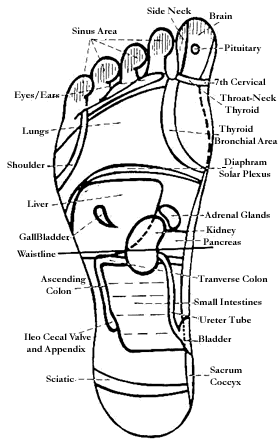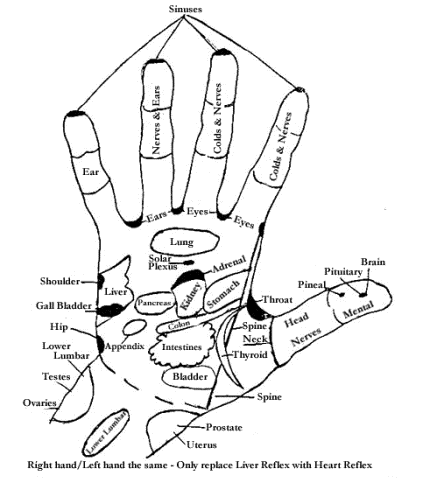Rub it better
by Joe Sinclair
[Biodata and picture of contributor will be found by clicking here]
INTRODUCTION
Few, if any, readers of this journal would fail to agree that massage, in one of its various forms, can be a useful aid to health and wellbeing. Most would probably go further and applaud the benefits of massage-related complementary practices such as reflexology, zone therapy, acupuncture/pressure, and many others. But how many readers, I wonder, are aware of the ease and beneficent potential in massaging oneself?
Massage can be self-applied both easily and effectively. When a person is unwell or suffering pain or discomfort, the spot where the discomfort or pain appears to be located is matched by another place in the body, known as a reflex point. A reflex is two separated areas that are in a relationship in the body. Hence reflexology. Rubbing or exerting pressure on the reflex point can effect a positive influence on the healing process.
Although results can be disappointing and sometimes necessitate a prolonged period of practice before they are achieved, they can also sometimes be startlingly dramatic. There are many recorded instances of people suffering, say, severe backache, who have effected almost instant relief - if not ultimately permanent cure - by massaging the reflex located a considerable distance from the immediate source of the pain, for example in the hand or the foot.
Our immediate impulse when we have some discomfort in any part of our body is to touch it with our fingers. Sometimes, depending on the cause of the discomfort and its apparent location, we may run the risk of aggravating the condition and causing more harm than good. But if we direct that impulse to the "reflex", we may at the very least enjoy some relief and, at best, start to effect a cure; and at the same time we will avoid the risk of inflaming the condition.
Another advantage of using the "reflex" to relieve a problem condition is that, in locating the reflex we are also locating the area whence the discomfort springs and this can be of help when seeking professional or clinical advice.
THE SIGNIFICANT AREAS
There are three main areas of the body where reflexes are located and where self-massage may be most effectively employed: these are the ears, the hands, and the feet. Each part of the whole body has a reflex on the ear, on the hand, and on the foot.
THE EARS
Three thousand years ago the Egyptians treated backaches by touching a specific point on the ear with a red hot needle. Five minutes after this dramatic treatment was performed, the back pains would miraculously disappear. Or so we are told. The key to auricular therapy is that there are points and zones on the ear which directly correspond to other parts of the body, as illustrated by Figure 1.
It may also be interesting to note that traditional acupuncture points for drug and alcohol addiction are located in the ears.
When massaging the ear it is suggested that you begin with moderate pressure and work over the entire ear on both sides. This technique will be employed also with hands and feet. Any areas of discomfort should be noted and, once the ear has been worked with moderate pressure, these areas should be rubbed more vigorously. Some relief may become apparent, but more likely this self-applied massage will have to be continued for some time before real benefits are obtained.
Figure 1. The Ears
[Click thumbnail to expand]
THE FEET
The toes and ball of the foot are reflex to the upper part of the body. The central area of the arch is reflex to the torso. The heel is reflex to the lower parts of the body - below the waist. But, when massaging the feet, it is more useful to massage without keeping specific reflex points in mind. Better is to massage in the way we describe below, until sore points are located, and then work on them.
Start with pressure massage over the entire foot - as was suggested for the ears - focusing first on the sole of the foot. Do not, however, neglect the top of the foot and the ankle area where many reflexes are located. As tender areas are noted, return to them and work on them specifically, stimulating them and working out the soreness. If effective, this will help the internal organs, glands and tissues, better to function.
As a rule the pressure is applied by the thumbs. Vary this with the use of bunched or extended fingers, knuckles, the heel of the hand, or a gripping motion with the whole hand, while the four fingers are pressed inwards. Pressure should start off light and gradually increase. A visual aid has been suggested as the pressure required to impress a new tennis ball, or the strength needed to pick up a brick between thumb and index finger. Never continue if the pressure begins to hurt. Note how the soreness changes over a period of days.

Figure 2. The Foot
THE HANDS
The basic technique is the same as for the feet. It is obviously easier, however, to work with the hands than with the feet. You can do this anywhere at any time.
Massage the hands all over with firm pressure, noting areas of tenderness. Return to the tender areas and administer firm pressure for a few minutes. As with the feet, these areas are reflex to organs and functions that are not operating at their most healthy levels.

Figure 3. The Hand